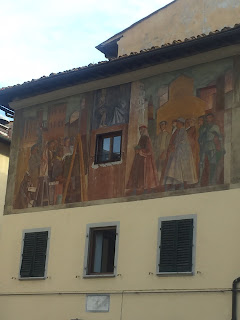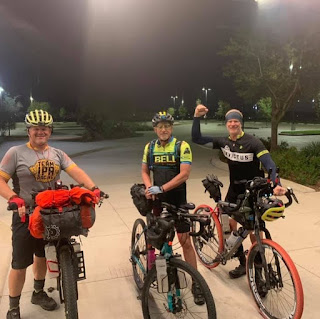Secondo Piatto e contorno / In Praise of the Beautiful and the Mundane
 |
| The fresco near my bus stop that I didn't notice my first 2 weeks here. |
We got deep in grammar this week in class: the passato remoto verbal tense and
the subjunctive mood. Passato remoto is a past tense that Italians rarely use
when speaking, but it is used all the time in news articles, historical
accounts and even children’s books. Subjunctive feels like an old friend, used
very similarly to the way it is in Spanish. Conceptually, I understand both of
these very well, but am not smooth with coming up with the correct conjugations
of the verbs. What has made me happy this week has been that my comprehension
and speaking ability, the two last language abilities to fall into place, are
getting much stronger. Language experts have written that speaking will not
come on line until comprehension starts to solidify and I believe this is true.
Before coming to Italy I would listen to an Italian podcast that was largely
incomprehensible, but listening to them this week, I was able to understand
nearly all of them.
The short afternoon sessions at school, great exercises in
themselves for listening comprehension, are on culture, history, art, etc., mostly
centered on Firenze itself and this week I heard something that really made me
stop and think. Firenze in the late 1400’s and 1500’s, under the sponsorship of
the Medici family (most notably Cosimo and Lorenzo) became a great patron and
protector of the arts.
 |
| Lorenzo Medici was not called "Il Magnifico" for his good looks |
One result was this beautiful city which has been
described as an open-air museum. Most of the buildings are works of art in
themselves. I’ll be waiting at the bus stop and just casually look up and see a
fresco, faded but still beautiful, that must be many centuries old, on the wall
of a building that now houses a coffee shop. People in charge at the time made
a decision to make things not only practical, but as beautiful as they could. The Medici's had a financial interest in works of art, and used them to build social
and economic capital, but they were also passionate art aficionados. And the Medici's, described as deeply Catholic, were also very free in their
consideration of what beauty could be depicted. Botticelli painted nude
representations of goddesses in addition to many Christian religious paintings.
 |
| Botticelli's Birth of Venus 1480's |
 |
| Michelangelo's David 1501-1504 |
And they left us with this beautiful city. I may spend the
rest of my life trying to understand the individual human impact of being in a
place where long-lasting, tasteful, beauty is so intentional and so built into
just about every street and structure. I find it very calming and reassuring to
be in it every day. It makes me glad that the Medicis were not cheese
merchants.
Margaret and I chose this weekend to rent a car and get away
to the coast. Lots of times since we’ve been here, as I’ve been hoofing around
in the heat or waiting in the sun to get on a crowded bus, I’ve thought, “I
sure will be glad when we rent a car and I can drive us around.” Well, we did
rent one and I soon after thought to myself, as Lee Corso likes to say, “Not so fast, my
friend.” Having your own wheels in Tuscany solves some problems and creates a
lot more. Liability, navigation at high speeds, getting through toll booths,
buying gas and parking were challenges that we had to work hard to overcome.
Driving in Italy is just different and you can see the difference reflected in the
geometry of personal space as you walk around the city. People are just
accustomed to being very close to each other and that closeness is extended to
vehicles on the road. As a result, it’s uncomfortable for us as we drive around
thinking, “That scooter that just whipped around me is too close to me. That
car that just whipped around me to fit itself into the safe following distance
I was leaving between myself and the car in front of me is too close to me. That bus that just jammed its 30-foot self
into this intersection is too close to all of us.” But you get used to it.
Figuring out all the systems: paying tolls, parking, operating
the washers and driers at the laundromat, getting a shopping cart at the
supermarket and operating the gas pumps is also a learning process. It’s not
even a language thing. It’s a system thing. Most of the time there’s no
language involved, just something like a metal leash that chains the shopping
carts together, that it seems like everyone else but you can figure out. So,
you either try to ask someone how to do it, or creepily watch over someone else's shoulder like a rhesus monkey as they do it, which is awkward and makes
you feel stupid. But you take solace in the fact that once you’ve figured it
out, it’s just one more thing you’ll know how to do next time.
One of the main things we wanted to do on our weekend
getaway was to go to the beach, so this morning we got an early start and went
out to Marina di Vecchiano.
We were hoping to beat the crowds, but we really
didn’t. So you, dear reader, may be thinking, “Ah ha. The beach in Europe. Do
tell.” Yes, there were a couple of topless women, but very few. And there were some
dudes in Speedos, more than topless women, but they also seemed to be in the
minority. It was crowded but pleasant, mostly families just enjoying the beach
like anyone else in the world does. There were a lot of old folks, and, really
just people of all ages, shapes and sizes. And it occurred to me that the
beachgoing crowd there seemed to be a little more egalitarian than we are in
the States. I think there are a lot of people who will just not go to the beach
in the States, and many others who will only go to the beach wearing a giant
t-shirt or cover-up, but that doesn’t seem to be the way it is for Italians (I
estimate the crowd was 95% local folks). The attitude seemed to be, “Here I am,
chillin’ at the beach. This is my body and I’m not going to cover it up much
more than absolutely necessary. I’m OK with it.”
 |
| I'm pretty sure that's a nerf dart and not a cigarette by Margaret's foot |
It strikes me as a very healthy attitude.
But don’t expect to see me in a Speedo at Lake DeGray,
Arkansas.


